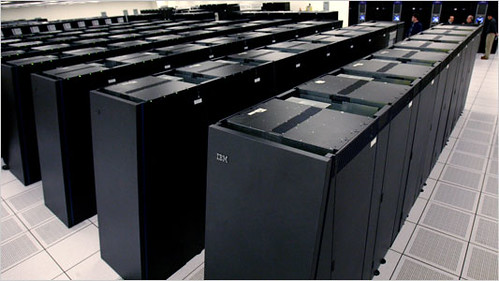I'm a big fan of IBM's Brain and Mind Institute (BMI) and the Blue Brain project. Initiated in May 2005, the Blue Brain project is an attempt to to model the mammalian cerebral cortex with computers. The intention is not to re-create the actual physical structure of the brain, but to simulate it using arrays of supercomputers. Ultimately, the developers are hoping to create biologically realistic models of neurons. In fact, the results of the simulation will be experimentally tested against biological columns.
But I take exception to the recent claim that IBM has created a simulation that is supposedly on par, in terms of complexity and scale, with an actual cat's brain. The media tends to sensationalize these sorts of achievements, and in this case, grossly overstate (and even misstate) the actual accomplishment.
Contrary to what some people may believe, IBM has not created a virtual cat. There's no simulated cat somewhere pouncing around simulated fields chasing simulated mice inside a supercomputer. All IBM has done is replicate the power of a cat's cebebral coretex using a bunch of powerful computers. Nothing more -- there's no psychological or AI element involved whatsoever. They're merely creating a physical power structure and computational infrastructure that may someday run a properly engineered mind.
But credit where credit is due.
IBM has made incredible progress in the sophistication and detail level of human brain mapping. By reverse engineering the human brain, IBM hopes to bring about the era of "cognitive computing," -- a development that would bring about new ways for building computers which mimic natural brain structures.
Essentially, IBM is hoping to simulate a neocortical column, which is the smallest functional unit of the neocortex. This is the part of the brain that is responsible for higher functions such as conscious thought. In humans, the neocortical column is 2mm tall, has a diameter of 0.5mm and contains 60,000 neurons. Project developers initially worked to replicate the neocortical column of a rat, which has only 10,000 neurons, and now they've achieved the same thing with the cat brain. Developers hope to model the human brain in about seven to eight years.
To model these components the developers use a Blue Gene supercomputer that runs the MPI-based 'Neocortical Simulator' combined with 'NEURON' software. Blue Gene is a computer architecture project that has will spawn several next-generation supercomputers -- computers that will reach operating speeds in the petaflops range, and are currently reaching speeds over 280 sustained teraflops. Its 8,000 processors will crunch away at 23 trillion operations per second.
I don't want to take away from IBM's accomplishment, but it's important to note that we are extremely far off in terms of our ability to emulate the true complexity of a mammalian brain. Creating an array of supercomputers that mimics the brute force of a biological brain and then claiming that it matches the 'complexity' and 'scale' of the real thing is pure hyperbole. True whole brain emulation (PDF) is still a far ways off.


That's an important clarification. I had fun reading the original article on the NIST website and then seeing how the story deteriorated as other news sources picked it up. Some sites were actually saying that a cat brain had been simulated.
ReplyDeleteLife lesson: the internet's blog system is a game of telephone.
"...we are extremely far off in terms of our ability to emulate the true complexity of a mammalian brain."
ReplyDelete7 or 8 years may be a little ambitious. But how many years is "extremely?" 15? 20?
Nobody expected in 1990 the Human Genome Project to now already be finished.
Nah, it's right around the corner and people are going to be stunned by how un-magical consciousness actually turns out to be.
in response to the comment..
ReplyDelete"7 or 8 years may be a little ambitious. But how many years is "extremely?" 15? 20?
Nobody expected in 1990 the Human Genome Project to now already be finished.
Nah, it's right around the corner and people are going to be stunned by how un-magical consciousness actually turns out to be."
It is sad how some people undervalue their own personality.
It is an interesting byproduct of recorded history. So many times we have learned about those who made asinine predictions about the future of technology, only to have the exact opposite come true.
Rather than exploring science for themselves, they have resigned themselves to the assumption that somehow humanity will conquer every problem out there, and that
"only the sky is the limit".